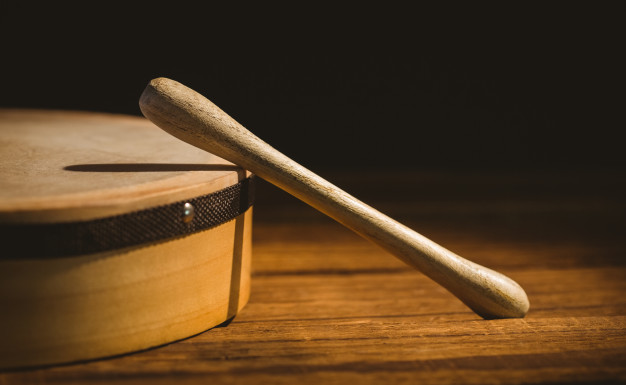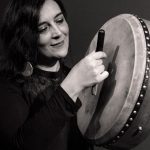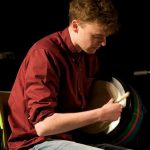
Bodhrán
Ita
Il bodhran è un tamburo di pelle di capra percosso con una piccola bacchetta di legno e con il suo ritmo anima le session di musica tradizionale irlandese.
Il bodhrán viene suonato percuotendolo con un piccolo mazzuolo di legno arrotondato ad entrambe le estremità, che il suonatore tiene tra pollice ed indice. Il timbro del bodhrán è grave e trova il suo massimo impiego nelle danze a tempo veloce, tipicamente i reel.
Mantenuto diritto sulle ginocchia, il musicista tiene il bastoncino nella mano destra come se fosse una penna, colpendo la pelle alternativamente con le due estremità, unicamente con i movimenti del polso.
Fra gli strumenti della musica tradizionale irlandese, il bodhràn è forse quello la cui storia è tra le meno chiare. Molte sono le spiegazioni disponibili per quel che riguarda le sue origini: la sua forma, molto vicina a quella di un setaccio, spinge alcuni musicologi a ritenere che l’idea stessa di tendere una pelle su una cornice arrotondata derivi da questo strumento agricolo.
Sebbene inizialmente fosse percosso con la mano, così come del resto la maggior parte degli strumenti a percussione in tutto il mondo, la successiva abitudine di usare un bastoncino risale a un’epoca ancora incerta, e costituisce una delle particolarità tipicamente irlandesi di questo strumento.
Il bodhrán è entrato nella strumentazione della musica irlandese in un periodo relativamente recente, soppiantando completamente il tamburello. Strumenti di struttura simile si ritrovano praticamente in tutte le culture. La forte somiglianza con alcuni tamburi in uso nell’esercito spagnolo ha suggerito l’ipotesi che l’introduzione del bodhrán possa essere avvenuto ad opera di irlandesi che avevano prestato servizio in tale esercito (cosa che accadeva abbastanza di frequente), o che avevano frequentato ex-coscritti incontrati a bordo di mercantili.
Altri hanno suggerito che il bodhrán derivi dai vassoi di pelle usati anticamente per trasportare la torba. Uno strumento in tutto simile al bodhrán e chiamato “riddle drum”, osservato da Peter Kennedy nelle contee Inglesi del Dorset e del Wiltshire, suggerisce una derivazione comune, anche se non è facile dire quale possa essere stato l’antecedente.
Eng
The word ‘Bodhrán’ derives from the old Gaelic ‘bodhar’, which translates as dull, numb or deaf.The basis of this type of drum is a wooden frame, and the playing surface is created by stretching an animal skin over this frame.
In times past the bodhrán was played either with a stick or the hand, and some drums had jingles on the rim, like the modern-day tambourine.
More recently, the sound has been refined by omitting the jingles, and greater tonal depth is achieved by players by dampening with their opposing hand.
The shape, size and even the frame and the tuning mechanism of this Irish drum continue to evolve today, meaning that there are a huge number of variations to be seen.
Before the onset of the 1950s, the bodhrán was probably most associated with the traditions of St Stephen’s Day, when it was played as part of the ancient ‘Hunting of the Wren’ ritual.
Credits: wikipedia.it – irlandando.it – wikipedia.com – theirishplace.com



